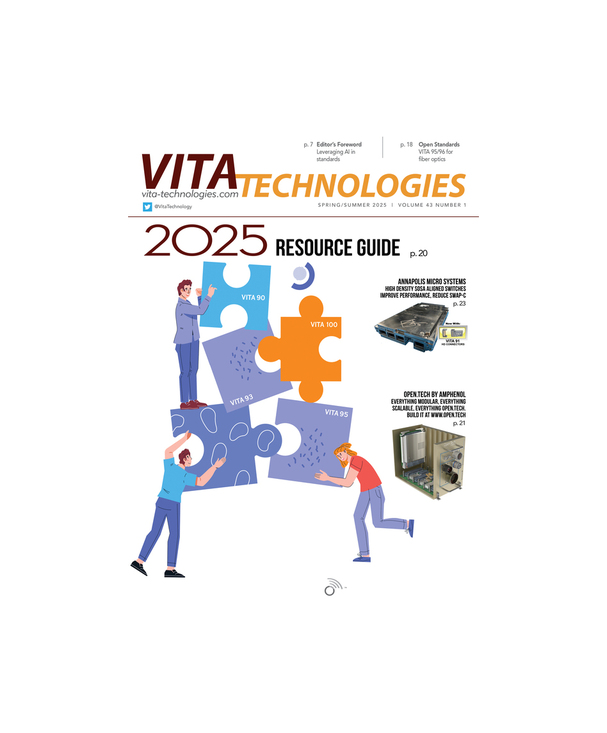Thirty years ago, at the System ’81 trade show held in October of 1981 in Munich, Motorola, Mostek, Signetics/Philips, and Thomson-CSF introduced the VMEbus – a 32-bit bus architecture jointly developed by the companies – and placed the specification in the public domain. Its introduction marked the birth of the modern embedded computing industry and a paradigm shift in the development and promotion of industry standards. Much has been written about the technical attributes of the architecture and its ability to absorb new capabilities in support of emerging technologies. When originally developed in 1980, the architecture was designed with a 10-year useful lifespan. While the past 30 years have seen multiple revisions of the specification to support new technologies in a backwards-compatible manner, with the advent of fabrics in lieu of parallel buses it is probably unlikely that further revisions to the VMEbus are forthcoming. However, the principles that guided the architecture’s development from its inception and enabled a thriving ecosystem will continue to guide the industry and assure its ongoing success.
Collaboration
The VMEbus specification was developed from its inception by multiple companies wishing to establish an industry standard in support of the 68000 microprocessor. While other manufacturers’ groups existed at the time, their mode of operation was to adopt a specification developed by a dominant player with minimal input from other companies and with little regard to other vendors’ products or interests. In contrast, the VMEbus specification was developed by all members of the VMEbus Manufacturers’ Group. Some refer to this as “co-opetition,” where multiple companies cooperate to create the technical dynamics required to enable a multivendor large market, and then compete to gain market share.
That spirit of collaboration was introduced by the architecture’s original developers and has been demonstrated ever since in all specification development activities undertaken by VITA/VSO. Most recently, such collaboration was demonstrated by the creators of the OpenVPX™ specification, where multiple vendors and potential customers banded together to develop VPX specification interoperability guidelines and thereby enable a larger market.
Open
When the VMEbus Manufacturers’ Group introduced the specification’s Revision A, they placed it in the public domain. The specification was not copyrighted so that it could be freely copied by all. Even though the specification introduced many technological innovations, the originators decided to refrain from filing any patents so that the architecture could be freely adopted. No licenses or license fees were required to develop and offer compliant products. All companies wishing to develop and sell products could do so under the same terms as other industry participants. By contrast, other bus architectures required that a license be granted and license fees paid to develop and sell compatible products.
While such an idealistic posture is difficult to adopt in today’s market realities, VITA’s ex ante IP policy requires all technical working group members to (1) disclose essential patents and patent applications and (2) declare Fair, Reasonable, And Non-Discriminatory (FRAND) licensing terms. Requiring that these be done while the specification is being developed and before the standard is approved preserves the spirit of openness and creates a level playing field for industry players.
Backwards compatibility
There is only one reason for developing specifications and driving them to become industry standards: to enable market growth. Once a new specification is developed and adopted, early adopters develop compliant products and customers – assured that products from multiple vendors interoperate – buy these products and develop end-use applications. It takes a number of years until wide adoption is achieved and the market realizes maximum benefits.
History shows that just as the market is picking up, technology requires that the spec be revised to support innovation. As an example, just as Revision C of the VMEbus specification started to gain momentum, the concept of VME64 was invented. Introducing that capability in Revision D, while maintaining backwards compatibility with revision C.1, prevented forklift upgrades and assured market continuity.
So, looking into the future and predicting what the next 30 years will bring to the VITA industry, I have to admit that I don’t know. Yes, data transfer technologies will continue to evolve with fabrics supporting data transfer speeds of 40 Gbps today to 100 Gbps in the not-too-distant future. I am almost sure that backplanes will finally have to adopt fiber optics, perhaps as soon as 100 Gbps transfer rates are required. Perhaps later. But I am totally convinced that whatever the technology, these three principles will continue to guide the VITA ecosystem in its efforts to maintain a high level of innovation:
- Collaborate to enable a big market
- Keep it open to reduce barriers to entry and enable a big ecosystem
- Innovate in a backwards-compatible manner to prevent forklift upgrades and assure market continuity






